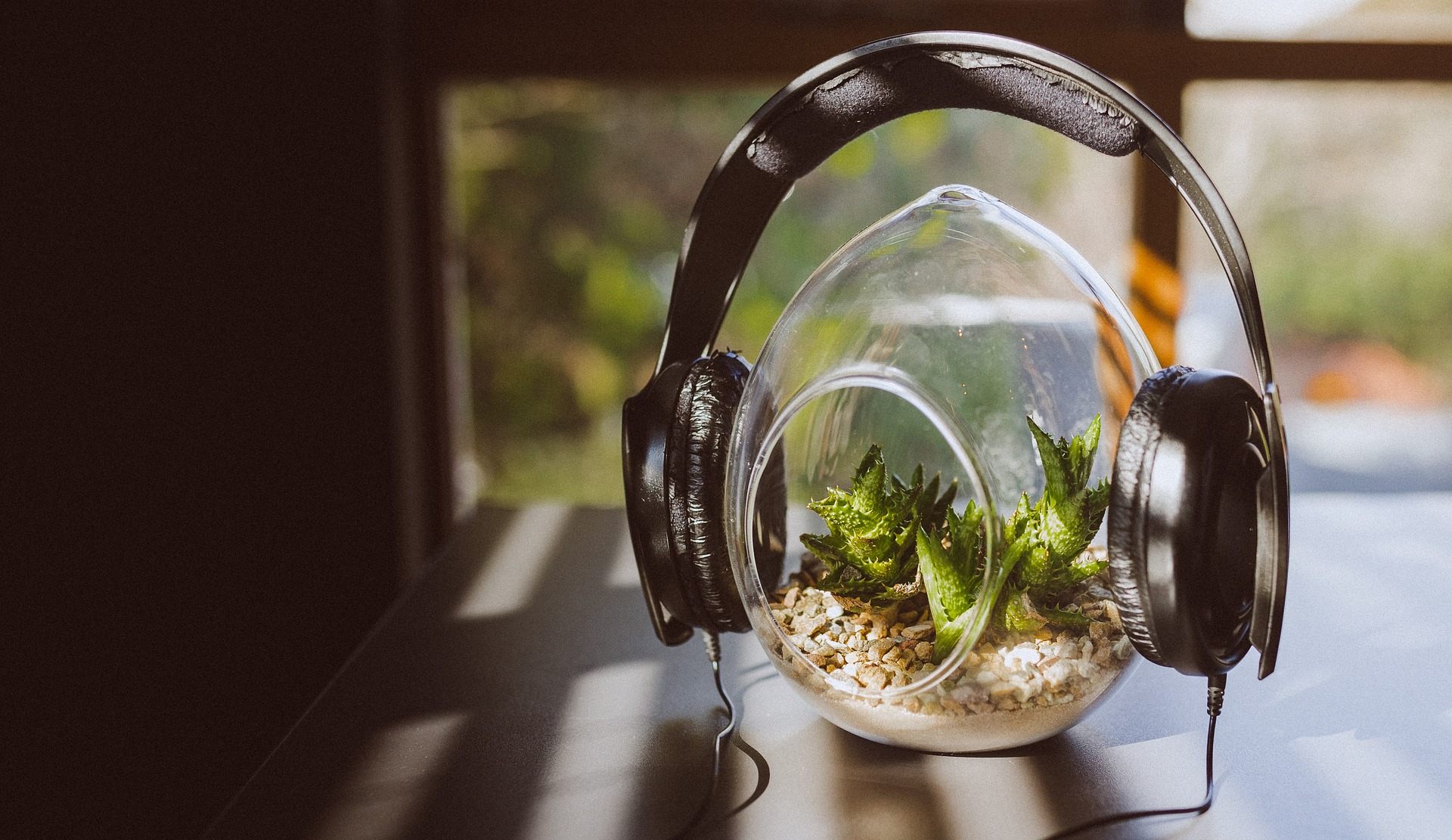A Dentist-Turned-Horticulturalist Made a Record Just for Plants
Dr. George Milstein believed that all plants needed to grow was water, sunlight, nutrients, and a swinging-Sixties soundtrack.

Each song on the 1970 album Music to Grow Plants starts out with a high-pitched whistling sound. These are, according to the liner notes, a sound “which acts upon plant growth patterns.” The notes have been “electronically embedded” into the record, which should mean, according to the description, that they are inaudible to humans. However, the notes caution “you may at times hear certain high frequency tones that could not be hidden completely.”
Those sounds are jarring, to say the least, especially when coupled with the plant-growing music, which has a gentle, ’60s cocktail-party sort of feel to it.
It’s almost charming to picture the album’s creator and cover star, retired dentist turned horticulture expert Dr. George Milstein, serenading his plants with this music for 45 minutes a day—a duration he recommended “to keep their pores open longer and wider, allowing a greater exchange with the air around them.” This regimen, to his mind, would help them grow.
Milstein was a firm believer in the science of sound when it came to his plants. A booklet enclosed with the record outlines his theory: “Just as all plant growth and flower development is stimulated by light vibrations, so it is logical to assume that the vibrations of sounds can also exert a beneficial influence on the horticulture of plants.”
As the president of the New York Horticultural Society, Milstein knew his way around a leaf. He was an expert in growing bromeliads—a variety of tropical plants—indoors, something that wasn’t easy to do. “I don’t want to sound immodest,” he told the New York Times in 1970, “but I am the authority on growing bromeliads in the home. They used to say it couldn’t be done.” Like all great pioneers before him, Milstein ignored the impossible. His home was covered in these impossible bromeliads, and all 300 of them were thriving, he insisted, because of his musical technique.

He claimed he tested his theories scientifically, under laboratory conditions, and found that plants “hearing” some sweet sounds grew faster than those not rocking out with their calyx out. “One plant bloomed in only six months when it ordinarily takes two years,” he said.
For all of his enthusiasm, plants were not always his main gig. Milstein had been a dentist for over 30 years when a bad hip forced him into retirement. Two plants gifted to him in 1958 by a patient started him down the path of the plant life. His retirement was just what he needed to move from hobbyist to plant-music professional.
Milstein wasn’t the first to suggest a link between music and plant growth, of course, and he wouldn’t be the last. Early 1900s studies by Bengali scientist Sir Jagdish Chandra Bose posited that music had an effect on plants. His work included the creation of the crescograph, an instrument used to measure plant growth and figure out what factors helped it. Bose believed that plant growth was not the only thing at stake, but a plant’s emotional well-being. Plants, he suggested, “feel pain and understand affection.”
Another plant-music researcher, a student named Dan Carlson, stumbled on Milstein’s record after returning home from military service in the early 1970s. He had enrolled in school in his native Minnesota with the mission of finding new ways to do agriculture, ways that would increase yields on any type of land. Milstein’s musical plant growth ideas were just the right starting point, and soon Carlson was experimenting himself, trying to find the right frequencies that made crops grow. He even made his own albums, first embedding those tones in raga music and then experimenting with other styles. According to his work, plants dug jazz but hard rock killed them in two weeks. Everyone’s a critic.
The boom of plant sounds continued with Mort Garson’s 1976 album Mother Earth’s Plantasia, an album consisting entirely of songs performed on Moog-synthesizer that claimed to aid plant growth. Even Stevie Wonder got into the act with the release of Journey Through the Secret Life of Plants in 1979, a soundtrack to a documentary of the same name. Although Wonder’s album made no claims that it would help out your wilting fern, the (much derided) documentary it accompanied relied heavily on Bose’s research and presented the thesis that plants have emotions.
University of Toledo plant sciences researcher Dr. Heidi Appel doesn’t ascribe human emotions to plants, but her work does show that plants do respond to sounds in their environments, and react to these sounds with chemical defenses. She can see why Milstein’s record, and the work to try to find connections between plants and music, would be so popular. “We’ve known for a long time that plants respond to music,” Appel says. “But no one knew why.”
Appel and her research partner Dr. Rex Cocroft published a paper in 2014 on their research to find out if plants could “hear” the sounds of insects eating them and defend themselves accordingly. The plants did respond to lab-recreated feeding vibrations, making a case for the fact that, on some level, plants can hear. But are they really like us, waiting to hear the first notes of their favorite songs? “People are drawn to plants aesthetically and viscerally, Appel says. “And to be able to connect with something that you’re drawn to and see similarities to yourself in them is irresistible. People are captivated by this field.”

Although Milstein was certainly captivated by the idea of plants responding to music, he was much less interested in making an album that would captivate listeners. Music to Grow Plants wasn’t even sold in record stores. Instead, his record would only be sold by florists and department stores. Milstein didn’t want to make a pop record. “I am not interested in a Top 10 novelty hit,” he said. He probably didn’t have to worry too much about that. The album is music at its most inoffensive, both to you and whatever plant may be listening. The composers were the U.S. arm of a U.K. music production company, an organization known for “library music,” the musical equivalent of stock photography. The music didn’t have to be groundbreaking, it just had to be pleasant, and it had to be good for your plants. But was it?
The plant might respond to music, says Appel, “but they don’t really have a good reason for it. Plants respond to sounds that are relevant to them.” So, the sound of a caterpillar munching on a leaf? Relevant. The sound of jazzy cocktail tunes? Not so much. “Plants have defenses and respond to stimuli,” says Appel. “[They] have a sense of hearing, but that hearing is selective, and about things relative to their environment.”
Ultimately, Milstein and others like him wanted us to see the connections between humans and the natural world. We need to protect them, and they in turn protect us. Milstein was convinced of that and didn’t just keep his plants around for their good looks. “Pollution is getting so bad that we’re eventually going to he spending 90 per cent of our time indoors,” he told the New York Times in 1970. “When that happens, indoor gardens won’t just he a matter of beauty—they’ll be a matter of health. We’ll be needing the oxygen the plants give off.” It is at its core a very environmentally friendly way of looking at the world. The problem that Appel sees with these sorts of claims, however, is that many of the experiments can’t be replicated.
“Plants might respond to music,” she says. “It might do something. It might disorient the pests, I don’t know. But we nurture plants, and [playing music to help them grow] is a way to get something in return, to imbue them with more meaning than they have. It’s motivated by good intentions.”



























Follow us on Twitter to get the latest on the world's hidden wonders.
Like us on Facebook to get the latest on the world's hidden wonders.
Follow us on Twitter Like us on Facebook